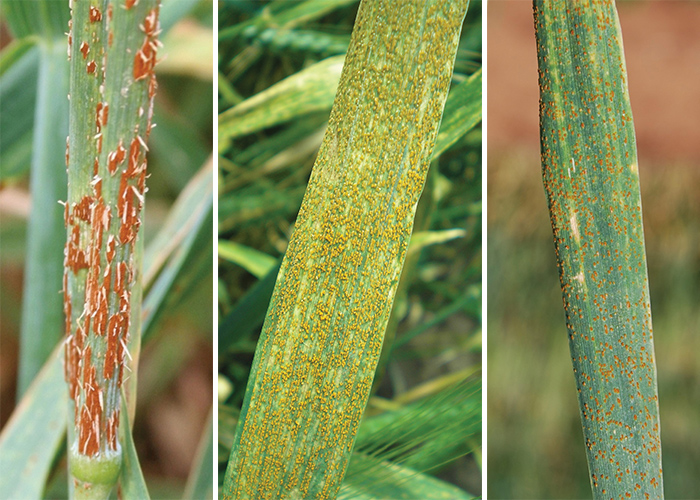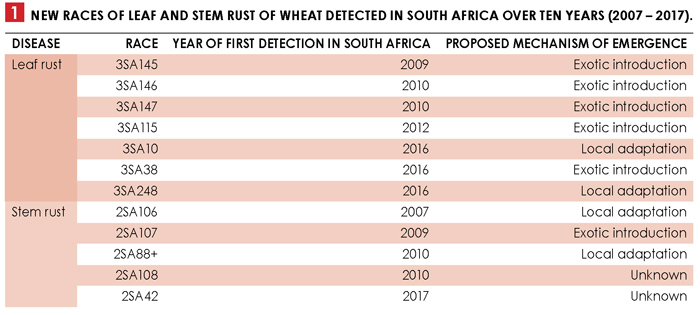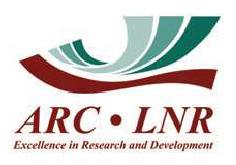
ARC-Small Grain,
Bethlehem
Exotic wheat rust incursions have significantly increased in South Africa in recent years. Therefore, ongoing rust surveillance conducted by ARC-Small Grain should be strengthened and supported as it will aid in the early detection and control of new rust races. This will ensure the development and sustained availability of resistant cultivars to wheat producers.
Rusts are one of the important diseases of bread wheat in South Africa. There are three types of rusts which are caused by different species of fungi. These are stem rust (black rust), leaf rust (brown rust) and stripe rust (yellow rust). These diseases can be identified based on the signs expressed on infected wheat plants (Photos). Stem rust produces dark-red, elliptical pustules (masses of spores) on the stems and leaves. Leaf rust primarily appears on the leaves as circular to oval orange-red pustules. Stripe rust appears as yellow masses of spores arranged in stripes on the leaf and leaf sheath.

All three types of rusts are found in South Africa, but their severity and importance in a specific area largely depends on climatic factors. Stem and leaf rust are favoured by warm temperatures of over 20˚C, while stripe rust infection commonly occurs under cool weather conditions (optimum 15°C to 18°C). Therefore, stripe rust is more important in the cooler wheat production areas such as the Eastern Free State, whereas stem rust and leaf rust are more prevalent in the Western Cape wheat-growing regions with mild winter temperatures. Rusts can cause extensive yield and quality losses by damaging the leaves and stems of wheat plants. Under favourable weather conditions, any of the three rusts can cause more than 50% yield loss on susceptible cultivars.
Resistant cultivars provide effective and environmentally friendly rust control. The main limitation of resistant cultivars is that their resistance may suddenly break down with the emergence of new rust races. New races can develop locally through genetic mutation taking place in existing races or they can be introduced into South Africa from other countries by their windborne spores or accidentally through human contact (clothes, shoes) and/or activities (farming equipment, vehicles).
Rust monitoring
To minimise the threat of continually evolving rusts, many wheat-growing countries undertake rust monitoring (surveillance). Similarly, through the National Rust Monitoring Programme at ARC-Small Grain, annual rust surveys have been performed for many years. These surveys cover rust trap nurseries planted at several localities and commercial wheat fields across the major wheat-growing regions of the country. Through these surveys, which have been conducted for over 40 years, new races have been timeously detected and used to continually upgrade wheat rust resistance in newly released cultivars.
A resistance breeding strategy currently followed by ARC-Small Grain involves development of cultivars with combinations of two or more race-specific resistance genes. This will increase the durability of resistance in the new cultivars, as it is less likely for a new rust race to overcome more than one resistance gene at the same time. In these breeding processes, conventional breeding methods are being supported by molecular methods, whereby molecular markers are used to rapidly select resistant germplasm. This will assist in the development of cultivars with resistance to a given rust disease in a relatively short time.
Increasing incursions of exotic rust races
Surveys conducted in South Africa during the past four decades detected several new races of both stem and leaf rust of wheat. These included races which emerged locally or through exotic introductions from other countries. The number of new race incursions has significantly increased in the country in recent years (Table 1). Between 2009 and 2016 alone, seven new leaf rust races (3SA10, 3SA38, 3SA115, 3SA145, 3SA146, 3SA147 and 3SA248) were identified (Boshoff et al., 2018). Phenotypic and genetic studies indicated that the majority of these new races (more than 70%) were most probably exotic introductions. Similarly, five new stem rust races (2SA42, 2SA88+, 2SA106, 2SA107 and 2SA108) were identified between 2007 and 2017, and at least one of these races was considered as representing a foreign incursion (Terefe et al., 2016).
 Most of these new races were also reported in other countries (Pretorius et al., 2015). For example, leaf rust race 3SA146 was detected in Zimbabwe and Zambia during 2011 and 2012, and 3SA147 was also confirmed in Zimbabwe in 2012. Race 3SA145 shared a high genetic similarity to a race found in one of the European countries, suggesting that Europe could be the ancestral origin of this leaf rust race (Terefe et al., 2014). Similarly, stem rust races such as 2SA88+ and 2SA107 were reported in other African countries including Zimbabwe and Mozambique, and 2SA42 was reported in Ethiopia, Kenya and Yemen. These reports suggest that other countries, especially those closer to South Africa, could be the sources of some of the new leaf and stem rust races detected in the country.
Most of these new races were also reported in other countries (Pretorius et al., 2015). For example, leaf rust race 3SA146 was detected in Zimbabwe and Zambia during 2011 and 2012, and 3SA147 was also confirmed in Zimbabwe in 2012. Race 3SA145 shared a high genetic similarity to a race found in one of the European countries, suggesting that Europe could be the ancestral origin of this leaf rust race (Terefe et al., 2014). Similarly, stem rust races such as 2SA88+ and 2SA107 were reported in other African countries including Zimbabwe and Mozambique, and 2SA42 was reported in Ethiopia, Kenya and Yemen. These reports suggest that other countries, especially those closer to South Africa, could be the sources of some of the new leaf and stem rust races detected in the country.
Overall, results of many years of surveys underscore the continued vulnerability of South African wheat crops to exotic as well as locally emerging rust races. Therefore, the ongoing rust surveillance programme at ARC-Small Grain should be strengthened and supported, as it will aid in the early detection and control of new races. Furthermore, races detected through such surveys will be used in germplasm screening and development of new cultivars, thereby ensuring continued availability of resistant cultivars to South African wheat producers.
References
- Boshoff et al., 2018. New Puccinia triticina races on wheat in South Africa. Australas Plant Path, 47: 325-334.
- Pretorius et al., 2015. Races of Puccinia triticina detected on wheat in Zimbabwe, Zambia and Malawi and regional germplasm responses. Australas Plant Path, 44: 217-24.
- Terefe et al., 2014. Diversity in Puccinia triticina detected on wheat from 2008 to 2010 and the impact of new races on South African wheat germplasm. Eur. J. Plant Pathol, 139: 95-105.
- Terefe et al., 2016. Variation in Puccinia graminis f. sp. tritici detected on wheat and triticale in South Africa from 2009 to 2013. Crop Protection, 86: 9-16.





























